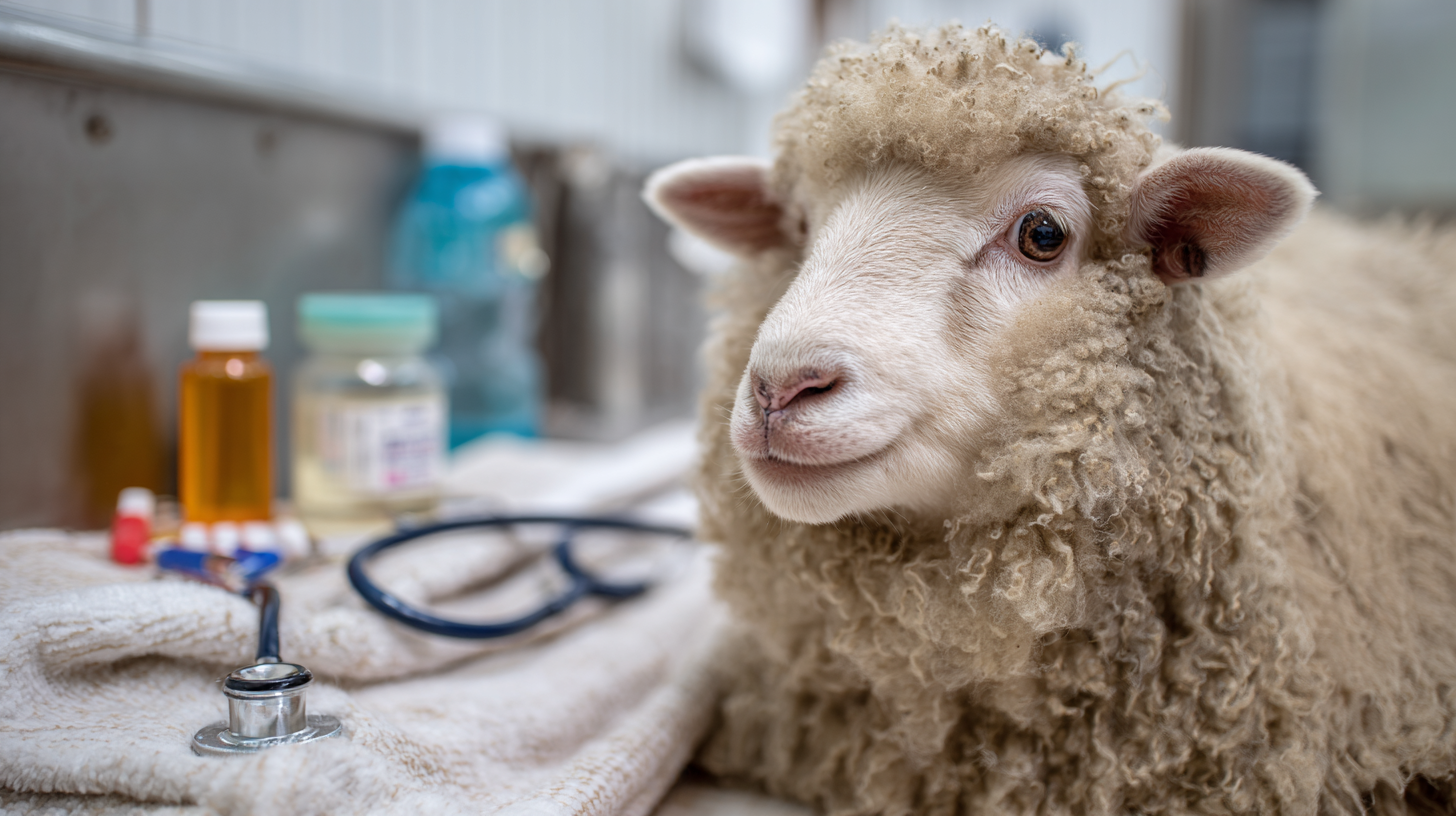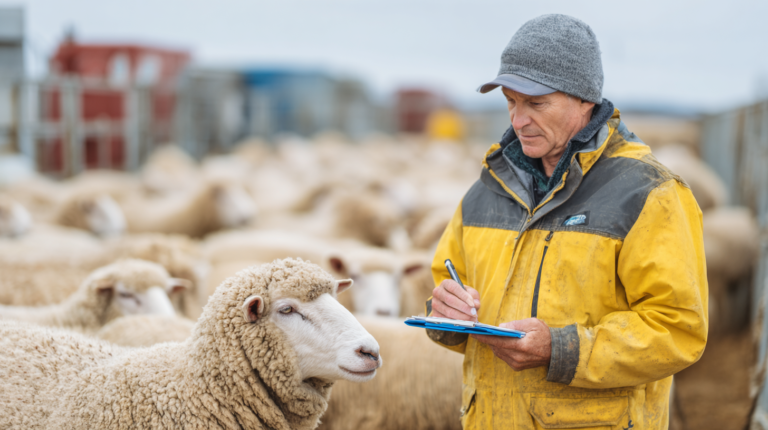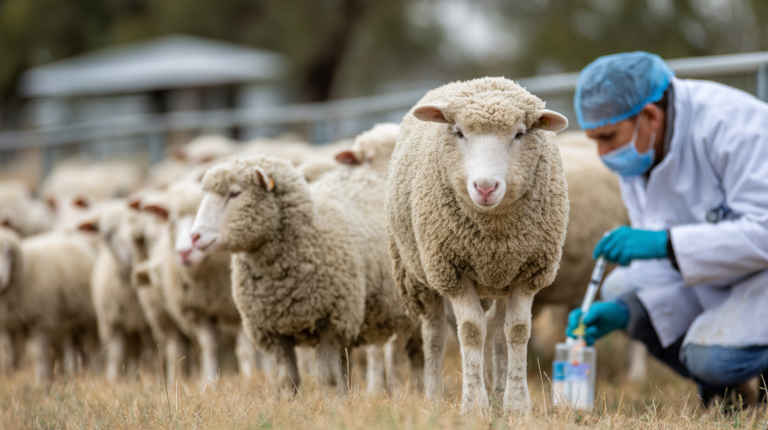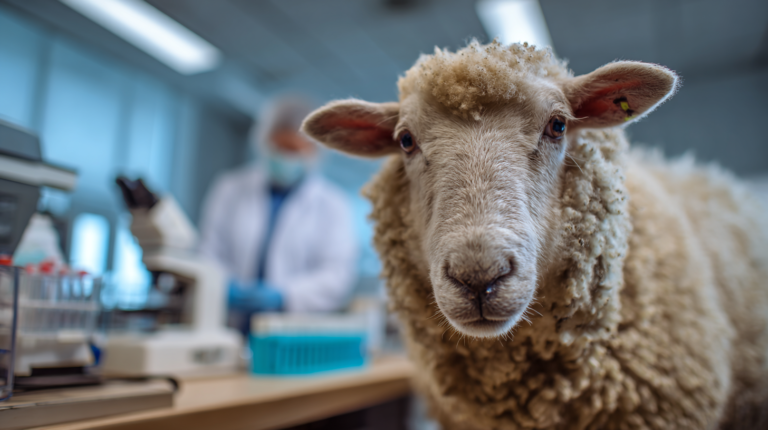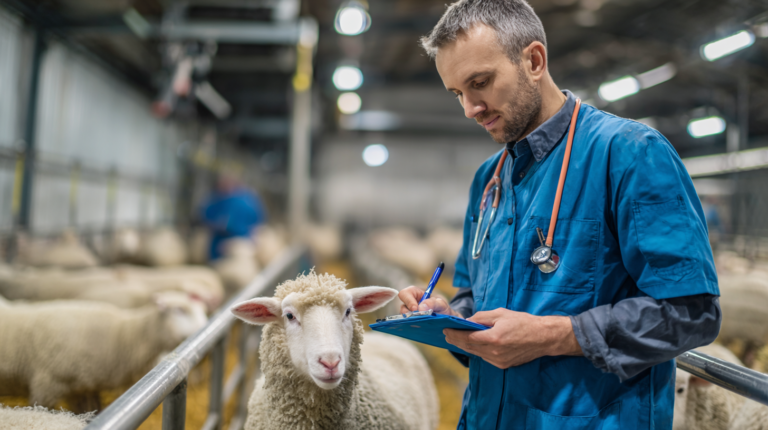Learn essential tips to prevent and treat pneumonia in sheep. Discover symptoms, causes, and veterinary-approved treatments to keep your flock healthy and thriving.
Table of Contents
Pneumonia in sheep represents one of the most significant respiratory challenges facing livestock owners today. This serious condition affects thousands of sheep annually, causing substantial economic losses and animal welfare concerns across farms worldwide. Understanding how to recognize, prevent, and treat pneumonia in sheep is crucial for maintaining a healthy flock and ensuring optimal productivity.
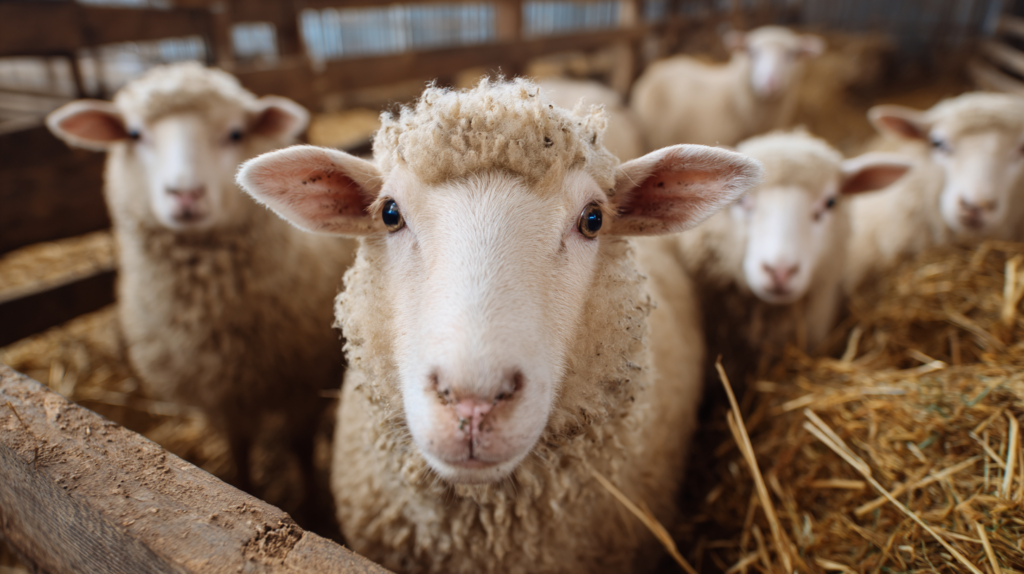
Respiratory diseases, particularly pneumonia, account for approximately 15-20% of all sheep mortalities in commercial operations. The condition can strike sheep of any age, though young lambs and stressed animals face the highest risk. Early detection and prompt treatment often mean the difference between recovery and loss, making it essential for sheep owners to develop comprehensive knowledge about this challenging disease.
Understanding Pneumonia in Sheep: The Basics
| Risk Factor | Risk Level | Prevention Strategy | Implementation Timeline |
|---|---|---|---|
| Poor Ventilation | High | Install adequate ventilation systems, ensure air circulation | Immediate (1-2 days) |
| Overcrowding | High | Maintain proper space allocation (4-6 sq ft per sheep) | Short-term (1 week) |
| High Humidity | Medium | Use dehumidifiers, improve drainage systems | Medium-term (2-4 weeks) |
| Extreme Temperatures | Medium | Provide shelter, heating/cooling systems as needed | Immediate (1-3 days) |
| Dusty Conditions | Medium | Regular cleaning, dust control measures | Ongoing daily |
| Transportation Stress | High | Pre-transport conditioning, minimize journey time | Pre-planning (1-2 weeks) |
| Sudden Feed Changes | Low | Gradual feed transitions over 7-10 days | Ongoing management |
| Weather Changes | Medium | Monitor forecasts, provide protective shelter | Seasonal preparation |
Pneumonia in sheep is an inflammatory condition affecting the lungs, typically caused by bacterial, viral, or parasitic pathogens. The disease manifests when infectious agents invade the respiratory system, causing inflammation in the alveoli (air sacs) and surrounding lung tissue. This inflammation impairs the sheep’s ability to exchange oxygen and carbon dioxide effectively, leading to respiratory distress and potential systemic complications.
The condition often develops secondary to other factors such as stress, poor ventilation, overcrowding, or compromised immune systems. Environmental stressors like extreme weather conditions, transportation, or sudden dietary changes can predispose sheep to pneumonia by weakening their natural defense mechanisms.
Several pathogens commonly cause pneumonia in sheep, including Pasteurella multocida, Mannheimia haemolytica, and Mycoplasma species. Viral infections such as parainfluenza virus and respiratory syncytial virus can also trigger pneumonia or create conditions that allow secondary bacterial infections to establish.
Recognizing the Signs: Symptoms of Sheep Pneumonia
Early recognition of pneumonia symptoms is critical for successful treatment outcomes. Sheep affected by pneumonia typically display a combination of respiratory and systemic signs that progress from mild to severe if left untreated.
Respiratory Symptoms
The most obvious signs of pneumonia in sheep involve the respiratory system. Affected animals often exhibit rapid, shallow breathing (tachypnea), with breathing rates exceeding 40 breaths per minute in adult sheep. Coughing represents another primary symptom, ranging from occasional dry coughs to persistent, productive coughing that may produce frothy or blood-tinged discharge.
Nasal discharge commonly accompanies pneumonia, initially appearing clear but progressing to thick, purulent material as the infection advances. Sheep may also display open-mouth breathing, extended neck posture, and audible respiratory sounds such as wheezing or crackling when breathing.
Systemic Symptoms
Beyond respiratory signs, pneumonia in sheep often causes systemic symptoms that reflect the body’s response to infection. Fever typically develops early in the disease process, with rectal temperatures exceeding 104°F (40°C) in affected animals. Lethargy and depression become evident as sheep lose interest in normal activities, spending more time lying down and showing reluctance to move.
Appetite loss (anorexia) commonly occurs, leading to decreased feed consumption and potential weight loss. Dehydration may develop secondary to fever and reduced water intake, evidenced by dry mucous membranes and decreased skin elasticity.
Behavioral Changes
Sheep with pneumonia often exhibit distinct behavioral modifications that alert observant owners to potential problems. Affected animals may separate themselves from the flock, seeking shelter or lying in unusual positions to facilitate breathing. Head shaking and ear drooping may occur as animals attempt to clear respiratory passages or respond to discomfort.
| Symptom | Severity Stage | Description | Action Required |
|---|---|---|---|
| Rapid Breathing | Early | Increased respiratory rate, shallow breaths | Monitor closely |
| Nasal Discharge | Early | Clear to cloudy discharge from nostrils | Monitor closely |
| Coughing | Moderate | Frequent, dry or productive cough | Veterinary consultation |
| Fever | Moderate | Body temperature above 103°F (39.4°C) | Veterinary consultation |
| Loss of Appetite | Moderate | Reduced feed intake, weight loss | Veterinary consultation |
| Lethargy | Moderate | Reduced activity, weakness, isolation | Veterinary consultation |
| Labored Breathing | Severe | Open-mouth breathing, extended neck | Emergency treatment |
| Blue Gums/Tongue | Severe | Cyanosis indicating oxygen deficiency | Emergency treatment |
| Collapse | Severe | Unable to stand, respiratory distress | Emergency treatment |
Tip 1: Implement Robust Prevention Strategies
Prevention remains the most effective approach to managing pneumonia in sheep, requiring a comprehensive strategy that addresses multiple risk factors simultaneously. A well-designed prevention program focuses on environmental management, vaccination protocols, and stress reduction techniques.
Environmental Management
Proper ventilation represents the cornerstone of pneumonia prevention in sheep housing. Adequate airflow removes moisture, ammonia, and airborne pathogens while maintaining optimal air quality. Barn ventilation should provide fresh air changes without creating drafts that could stress animals or promote respiratory irritation.
Stocking density plays a crucial role in preventing pneumonia outbreaks. Overcrowded conditions increase pathogen transmission rates and elevate stress levels, creating ideal conditions for disease development. Maintaining appropriate space allowances of at least 15-20 square feet per adult sheep in indoor facilities helps reduce infection pressure.
Regular cleaning and disinfection of housing areas, feeding equipment, and water systems eliminate pathogen reservoirs that could trigger pneumonia outbreaks. Using approved disinfectants and following proper cleaning protocols ensures effective pathogen reduction while maintaining animal safety.
Vaccination Programs
Strategic vaccination protocols provide crucial protection against common pneumonia-causing pathogens. Clostridial vaccines combined with respiratory disease vaccines offer broad-spectrum protection against multiple disease agents. Vaccination timing should align with local disease patterns and seasonal risk factors.
Adult sheep typically receive annual boosters, while breeding ewes benefit from pre-breeding vaccination to ensure passive antibody transfer to lambs. Lamb vaccination programs should begin at 6-8 weeks of age, with boosters administered according to manufacturer recommendations and veterinary guidance.
Stress Reduction Techniques
Minimizing stress factors significantly reduces pneumonia susceptibility in sheep flocks. Gradual transitions when changing feed, avoiding abrupt environmental changes, and maintaining consistent management routines help preserve immune function and respiratory health.
Transportation stress requires particular attention, as movement and handling can precipitate pneumonia outbreaks. Implementing proper loading procedures, maintaining appropriate vehicle ventilation, and allowing adequate recovery time after transport help minimize respiratory disease risk.
Tip 2: Master Early Detection and Rapid Response
Early detection of pneumonia in sheep dramatically improves treatment outcomes and reduces mortality rates. Developing systematic monitoring protocols and establishing clear response procedures ensures prompt intervention when respiratory disease occurs.
Daily Health Monitoring
Implementing daily health checks allows early identification of pneumonia symptoms before they progress to severe stages. Monitoring should include visual assessment of breathing patterns, nasal discharge, and general demeanor during routine feeding and management activities.
Temperature monitoring using rectal thermometers provides objective data about potential infections. Normal sheep body temperature ranges from 101.5-103.5°F (38.6-39.7°C), with readings above 104°F (40°C) indicating fever requiring immediate attention.
Behavioral Observation
Training farm staff to recognize subtle behavioral changes helps identify sick animals before obvious clinical signs develop. Sheep showing decreased appetite, reduced activity, or separation from the flock warrant closer examination for potential respiratory disease.
Breathing pattern assessment should become routine during flock observations. Normal sheep breathing appears effortless and regular, while pneumonia-affected animals display labored, rapid, or irregular respiratory patterns.
Response Protocols
Establishing clear response protocols ensures consistent and appropriate action when pneumonia is suspected. These protocols should include immediate isolation procedures, veterinary consultation guidelines, and treatment initiation steps.
Isolation of suspected cases prevents disease spread while allowing focused treatment efforts. Separate housing should provide adequate ventilation, easy access for treatment, and reduced stress conditions that support recovery.
Tip 3: Optimize Treatment Approaches
Effective treatment of pneumonia in sheep requires prompt veterinary intervention combined with supportive care measures. Treatment success depends on early diagnosis, appropriate antibiotic selection, and comprehensive supportive therapy.
Antibiotic Therapy
Antibiotic treatment forms the primary intervention for bacterial pneumonia in sheep. Selection should be based on culture and sensitivity testing when possible, though empirical treatment often begins before laboratory results are available. Commonly effective antibiotics include florfenicol, tulathromycin, and oxytetracycline.
Treatment duration typically ranges from 3-5 days, though severe cases may require extended therapy. Proper dosing according to body weight and manufacturer recommendations ensures therapeutic levels while minimizing resistance development.
Supportive Care
Supportive care measures significantly improve treatment outcomes by addressing systemic effects of pneumonia. Ensuring adequate hydration through increased water access or electrolyte supplementation helps maintain physiological function during recovery.
Nutritional support becomes critical as appetite may be reduced during illness. Providing high-quality, easily digestible feeds and ensuring access to palatable water sources supports immune function and healing processes.
Anti-inflammatory Medications
Non-steroidal anti-inflammatory drugs (NSAIDs) can provide symptomatic relief and reduce fever associated with pneumonia. However, their use requires careful consideration of potential interactions with antibiotics and individual animal status.
Veterinary consultation is essential before implementing anti-inflammatory therapy, as these medications can have contraindications in certain disease states or when combined with other treatments.
Tip 4: Focus on Flock-Wide Management
Managing pneumonia in sheep requires a flock-wide approach that addresses both affected animals and prevention of disease spread. Comprehensive management strategies help control outbreaks while maintaining overall flock health.
Quarantine Procedures
Implementing effective quarantine procedures prevents pneumonia spread while allowing focused treatment of affected animals. Quarantine facilities should provide adequate ventilation, easy access for treatment, and reduced stress conditions.
New animals entering the flock should undergo quarantine periods of 21-30 days to prevent introduction of respiratory pathogens. During quarantine, animals should be monitored for signs of illness and receive appropriate vaccinations.
Biosecurity Measures
Robust biosecurity protocols help prevent pathogen introduction and limit disease spread within flocks. These measures include visitor restrictions, equipment disinfection, and proper disposal of deceased animals.
Feed and water source protection prevents contamination that could contribute to disease outbreaks. Using dedicated feeding equipment and maintaining clean water systems reduces pathogen exposure risks.
Environmental Modifications
During pneumonia outbreaks, environmental modifications can help reduce disease severity and prevent spread. Improving ventilation, reducing stocking density, and providing additional shelter help minimize stress factors that exacerbate respiratory disease.
Temperature control becomes particularly important during treatment, as affected animals may have difficulty maintaining body temperature. Providing adequate bedding and draft protection supports recovery efforts.
Tip 5: Develop Long-term Prevention Strategies
Long-term prevention of pneumonia in sheep requires ongoing attention to flock health, environmental conditions, and management practices. Sustainable prevention strategies focus on building flock immunity and maintaining optimal health conditions.
Breeding for Resistance
Selective breeding programs can improve flock resistance to respiratory diseases including pneumonia. Identifying and retaining animals with superior health records and respiratory resistance contributes to long-term flock improvement.
Genetic selection should consider multiple health traits while maintaining production characteristics. Working with breeding specialists helps develop selection criteria that improve disease resistance without compromising productivity.
Nutritional Management
Proper nutrition plays a crucial role in maintaining respiratory health and immune function. Ensuring adequate protein, energy, and micronutrient intake supports natural defense mechanisms against respiratory pathogens.
Vitamin E and selenium supplementation may provide additional respiratory health benefits, though supplementation should be based on forage analysis and regional deficiency patterns. Trace mineral balance also influences immune function and disease resistance.
Seasonal Considerations
Developing season-specific management strategies helps address varying pneumonia risk factors throughout the year. Winter management may focus on ventilation and housing, while summer strategies might emphasize dust control and heat stress prevention.
Lambing season requires particular attention to pneumonia prevention, as newborn lambs face increased susceptibility to respiratory disease. Ensuring clean lambing environments and adequate colostrum intake helps protect young animals during vulnerable periods.
The Role of Veterinary Partnership
| Timeline Phase | Action Required | Priority Level | Expected Outcome | Success Rate |
|---|---|---|---|---|
| 0-6 Hours | Initial symptom recognition, temperature check, isolation | Critical | Early intervention prevents progression | 90-95% |
| 6-12 Hours | Veterinary consultation, diagnostic sampling | Critical | Accurate diagnosis enables targeted treatment | 85-90% |
| 12-24 Hours | Antibiotic therapy initiation, supportive care | High | Treatment response becomes evident | 80-85% |
| Day 2-3 | Monitor treatment response, adjust protocols | High | Symptom improvement or protocol revision | 75-80% |
| Day 4-7 | Continue treatment, nutritional support | Medium | Progressive recovery, appetite return | 70-75% |
| Week 2 | Treatment completion, recovery assessment | Medium | Full recovery or chronic management needed | 65-70% |
| Week 3-4 | Return to flock evaluation, follow-up monitoring | Medium | Complete integration or ongoing care | 60-65% |
| Month 1+ | Long-term monitoring, prevention reassessment | Medium | Permanent recovery or chronic complications | Variable |
Successful pneumonia management in sheep requires strong veterinary partnerships that provide expertise, diagnostic capabilities, and treatment guidance. Regular veterinary consultation helps develop effective prevention and treatment protocols tailored to specific flock conditions.
Diagnostic Services
Veterinary diagnostic services provide crucial information for effective pneumonia management. Necropsy examinations of deceased animals help identify causative pathogens and guide treatment decisions for remaining flock members.
Culture and sensitivity testing helps select appropriate antibiotics and monitor resistance patterns. These services ensure treatment effectiveness while promoting responsible antibiotic use.
Treatment Protocols
Developing written treatment protocols in consultation with veterinarians ensures consistent and appropriate responses to pneumonia cases. These protocols should address antibiotic selection, dosing regimens, and supportive care measures.
Regular protocol review and updates help incorporate new treatment options and address changing pathogen patterns. Veterinary input ensures protocols remain current with best practices and regulatory requirements.
Herd Health Planning
Comprehensive herd health planning addresses pneumonia prevention within the context of overall flock management. These plans should include vaccination schedules, monitoring protocols, and response procedures for disease outbreaks.
Regular plan reviews and updates help address changing conditions and incorporate new management strategies. Veterinary involvement ensures plans remain scientifically sound and practically applicable.
Economic Considerations
Pneumonia in sheep creates significant economic impacts through mortality, reduced productivity, and treatment costs. Understanding these economic factors helps justify prevention investments and guide management decisions.
Direct Costs
Direct costs of pneumonia include mortality losses, treatment expenses, and veterinary fees. Lamb mortality from pneumonia can reach 10-15% in severe outbreaks, representing substantial economic losses for commercial operations.
Treatment costs include antibiotic expenses, supportive care products, and additional labor requirements. These costs can accumulate rapidly during outbreaks, emphasizing the value of prevention strategies.
Indirect Costs
Indirect costs often exceed direct expenses and include reduced growth rates, delayed marketing, and decreased reproductive performance. Surviving animals may experience long-term effects that impact productivity and profitability.
Market weight delays of 2-3 weeks commonly occur following pneumonia episodes, affecting cash flow and production schedules. Breeding animal performance may also be compromised, leading to reduced conception rates and lamb production.
Prevention Investment
Prevention program costs typically represent a fraction of treatment and loss expenses. Vaccination programs, environmental improvements, and management changes require initial investments but provide substantial returns through reduced disease incidence.
Cost-benefit analyses consistently demonstrate the economic advantages of comprehensive prevention strategies compared to treatment-focused approaches. Investment in prevention helps maintain stable production and profitability.
Frequently Asked Questions
Everything you need to know about pneumonia in sheep
For more expert pet care tips and product recommendations, visit BlithePet.com — your trusted source for pet wellness.
Conclusion
Pneumonia in sheep represents a serious health challenge that requires proactive management, early detection, and prompt treatment. The five essential tips outlined in this comprehensive guide provide a framework for preventing, recognizing, and treating this significant respiratory disease.
Successful pneumonia management depends on implementing robust prevention strategies that address environmental factors, vaccination protocols, and stress reduction. Early detection through systematic monitoring and behavioral observation enables rapid response that dramatically improves treatment outcomes. Optimized treatment approaches combining appropriate antibiotics with supportive care provide the best chance for recovery.
Flock-wide management strategies help control disease spread while maintaining overall health, while long-term prevention focuses on building sustainable resistance through breeding, nutrition, and seasonal management. The economic benefits of prevention consistently outweigh treatment costs, making comprehensive prevention programs essential for profitable sheep operations.
Remember that veterinary partnership remains crucial for developing effective pneumonia management protocols tailored to your specific flock conditions. Regular consultation, diagnostic services, and treatment guidance ensure optimal outcomes while promoting responsible antibiotic use and animal welfare.
By implementing these evidence-based strategies and maintaining vigilant monitoring, sheep owners can significantly reduce pneumonia incidence and severity in their flocks. The investment in prevention and early intervention pays dividends through improved animal health, reduced mortality, and enhanced productivity.
Have a similar experience with your pet? Share it in the comments below!

